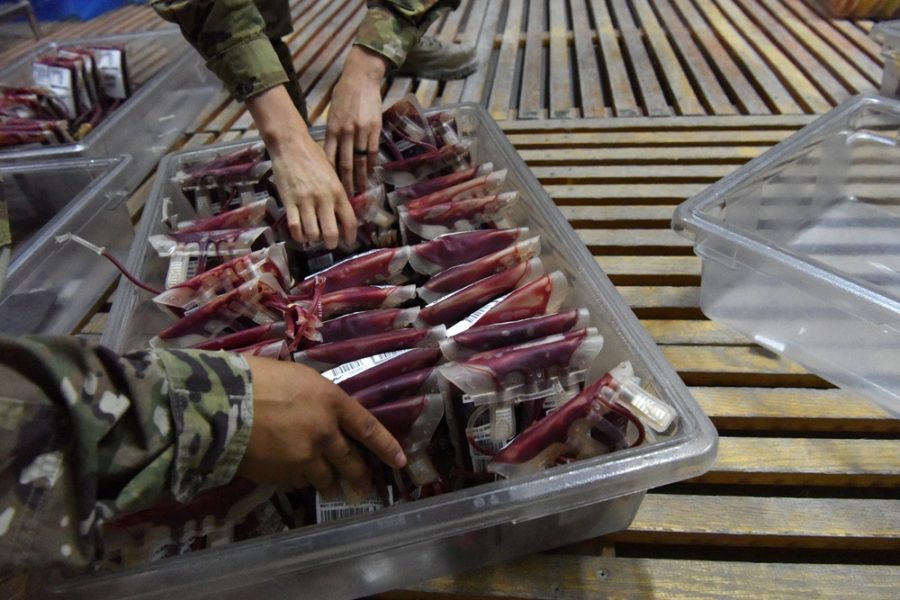The Department of the Air Force’s annual Spark Tank competition takes place March 4, when six teams will take to the stage at the AFA Warfare Symposium in Orlando, Fla. Teams will pitch their ideas to the most senior leaders in the Air and Space Forces on how their innovations can save money, improve the lives of Airmen and Guardians, and transform the department. Air Force Magazine is highlighting one team each day from now through March 3. Today, we look at “Blood Delivery by UAV” led by Maj. Giselle Rieschick of Air Combat Command’s 99th Medical Support Squadron at Nellis Air Force Base, Nev.
The “blood banker” community in the Air Force is small but vital. When things go wrong and the delivery of blood can mean the difference between life and death for a service member, “you can’t fail,” Rieschick told Air Force Magazine. “Missions get scrubbed. People get hurt.”
Yet when Rieschick deployed recently to Al Udeid Air Base, Qatar, she encountered a frustrating problem. A service member needed blood, and a team with that blood got within 20 minutes of the member’s location. But the blood never got there.
“We couldn’t bridge that last tactical mile … because the risk was just too great to other members,” Rieschick said. “I mean, what am I going to do, send out a Blackhawk with six guys on it that can get shot down?”
The service member survived, but the incident sparked Rieschick and her team to start exploring a new way to ensure blood supplies get to troops in need.
Currently, Rieschick said, the Defense Department spends millions supplying individual units with “just-in-case inventory”—a little bit of blood in case something goes wrong. This system has mostly been in place since the 1990s, she said.
“But if you have one guy or gal having a very bad day, that little bit of product isn’t going to be enough to sustain them,” Rieschick said. “So we suggest that we flip the script here. What if we pre-positioned … a UAV at a central location—because a lot of these teams that support one another, they have a central location that has more blood, but somebody has to call them and drive the blood out, and it gets very complicated.
“So what if, when they needed the help and they radioed it in to their nearest blood detachment center, that team sitting in that building with those products could load it and send it? They wouldn’t have to go to the flight line. They wouldn’t have to go through all these channels and say, ‘Who can help me get this blood here?’”
The use of unmanned aerial vehicles, or drones, to deliver medical supplies is not a new idea. It has been used everywhere from Africa to Israel to North Carolina to get supplies to remote locations, to limit contact, or to increase convenience.
In a military context, however, the idea could be especially potent, Rieschick said. Low-cost attritable aircraft such as UAVs can be sent into dangerous situations without added risk to human life. They can deliver the large quantities of blood sometimes needed in combat situations. And they can simplify what is now a complicated logistical effort.
As part of the Spark Tank competition, Rieschick and her team are asking for $500,000. That would be enough to buy two commercially-available UAVs with the necessary range and strength, as well as three range extenders—towers that can be loaded onto pickup trucks to extend how far the drone can fly.
But as Rieschick sees it, her request is just the beginning. The concept of using UAVs for delivering critical supplies can be applied in a multitude of ways, and she expects the demand to only grow in the years ahead.
“What I see is that this capability to deliver things to a pinpoint location is not going to be limited to blood. Whether you’re going ship-to-shore in [INDOPACOM], or you’re doing logistical support in COCOM … they’re going to use this for other things that are needed, because there are many, many ‘crazy-makers’ where you’re just like, ‘I just … need this sent here’,” Rieschick said.
“But we always rely on a ton of logistical support from the flight line, and there’s some things that just—I don’t need them for that. They need to be focusing on their own missions.”
And not just the Air Force would benefit from the idea, Rieschick added. As service leaders continue to emphasize the importance of the joint force, “Blood Delivery by UAV” stands out as an obvious example of that.
“We need to start thinking jointly. How can we help one another and quit thinking about Army and quit thinking about Air Force and quit thinking about being Marines?” Rieschick said. “There are times for that, yes. But in normal everyday ops, there are ways we can help each other, and a UAV doesn’t care what color you are. A UAV is purple.”


